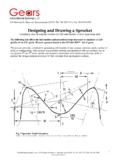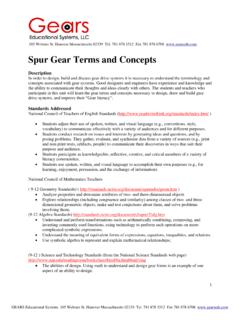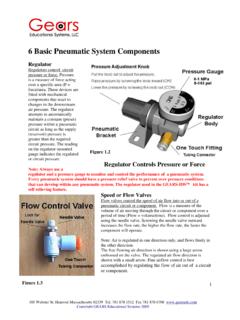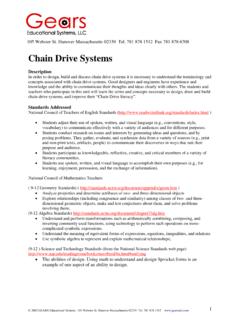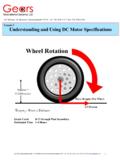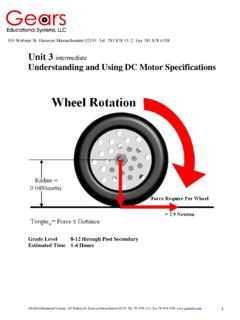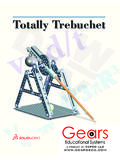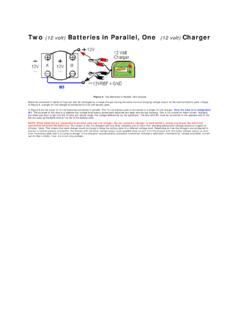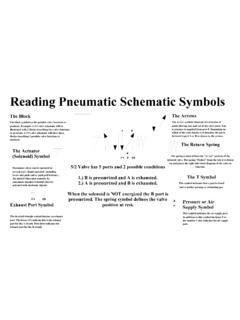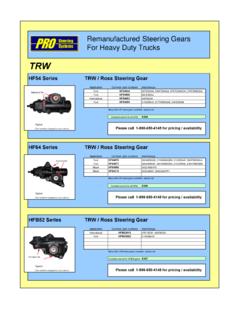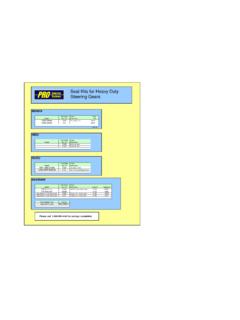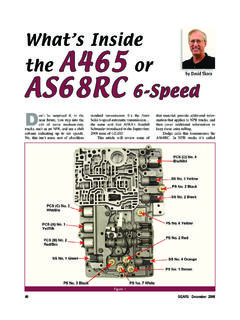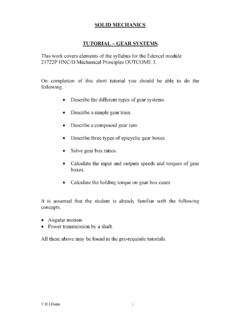Transcription of Pressure in Pneumatic Systems - Gears Educational Systems
1 Pressure in Pneumatic Systems Using Pneumatic Systems to Perform Work and Power Mechanisms Pressure in Pneumatic Systems The science of compressed air We live at the bottom of a sea of air. The upper limit of the earth's atmosphere is not clearly defined, but it is safe to say that most of the earth's atmospheric mass lies within 100km or about 60 miles above the surface. Air has mass, and therefore it is affected by gravity. Gravity acts on the particles of air and gives them weight. The weight of the air above us creates a Pressure around us. When you push down on the handle of a bicycle pump, you are putting a force equal to some of your weight on the handle. The handle is attached to a rod and piston within the pump.
2 The force of your weight pushing down on the piston reduces the volume of air in the pump, and raises the Pressure . The weight of the air above us does the same thing to the air around us. We are not aware of the weight of the ocean of air above us, because we were born into it. We have never been without it. Without the Pressure of this ocean of air around us, we would not be able to breathe. Hold your hand on your chest and inhale deeply. Can you feel your chest expand? As you expand your chest muscles, your lungs increase in volume and the Pressure of the ocean of air around us forces air into your lungs! Without the Pressure of the ocean of air, you would not be able to breathe. Climbing higher into the atmosphere reduces the depth of air above you and thus reduces the mass and weight of the air above you.
3 This results in a lower air Pressure and makes it hard to breathe. Climbers on the world's highest peaks bring bottles of oxygen with them in order to survive at high altitudes. Air Pressure at Sea Level Air Pressure varies across the face of the earth. The most significant factors that affect air Pressure are temperature, wind and altitude. For our purposes we will consider standard atmospheric air Pressure to be pounds per square inch. Gears Educational Systems 105 Webster St. Hanover Massachusetts 02339 Tel. 781 878 1512 Fax 781 878 6708 1. There are many units of measurement for Pressure . We will consider only 2. Standard Pressure = psi (Pounds per square inch) or mega Pascal Note: a Pascal is a very small unit of Pressure equal to the force exerted by 1 Newton acting over an area of 1 square meter.
4 Therefore we use units of mega or millions of Pascals to describe standard air Pressure or multiples of standard air Pressure . Pressure is a Force Acting Over an Area Pressure is described as the amount of Force acting on a specified Area. Mathematically Pressure looks like this. Force Pr essure =. Area Pressure is a force exerted by a fluid or a gas and it is transmitted in all directions equally throughout the fluid/gas. Pressure acts on the surface area of the vessels or chambers in which it is confined. Consider the reservoir in the Gears -IDS . Pneumatic circuit you are using. The reservoir is a hollow cylinder with internal Figure 7. dimensions that are approximately 1-1/2 . in diameter x 5-1/2 long.
5 The end caps are circular with an internal diameter of approximately 1- 1/2 . Study the cross section drawing of the reservoir below: 100 PSI. Figure 8. The drawing above illustrates a Gears -IDS reservoir filled to 100 psi or 100 pounds per square inch of Pressure . This is an example of a fixed volume (The interior space of the reservoir) with a fixed amount of air contained within it. Gears Educational Systems 105 Webster St. Hanover Massachusetts 02339 Tel. 781 878 1512 Fax 781 878 6708 2. The Nature of Air Pressure One way of visualizing Pressure is to think about the atomic model. The air within the cylinder is made up of highly energized (Rapidly moving) particles called molecules. The air is made up of different gases that can be visualized as a mixture or Soup of different gas molecules.
6 Each one of these molecules are surrounded by a negatively charged cloud we call electrons. The example below provides a means of visualizing two gas particles or molecules, each surrounded by a negatively charged cloud of electrons. _ _. _ _ _. _ _. _ _ _ _. _ _. Figure 9. We recognize that like charges repel each other. Figure 10. Negative Charge 1 Negative Charge 2. We also recognize that unlike charges attract each other: Figure 11. +. Thinking of a gas as being made up of particles surrounded by a negatively charged cloud, it's easy to see that the gas particles are going to resist being pushed together. This is similar to what happens when you bring (2) similar magnetic poles into contact.
7 The closer they are pushed together, the more they resist being pushed together .try it! This is what happens to air molecules. They can be pushed together, but the more you try to push them closer together, the harder they resist. The amount or force of this resistance is what causes Pressure ! Gears Educational Systems 105 Webster St. Hanover Massachusetts 02339 Tel. 781 878 1512 Fax 781 878 6708 3. Air Pressure Activity Example This is an activity that can help you visualize what is happening as you pump more and more air into the reservoir. Materials: Pringles potato chip can or tennis ball can. Foam mattress pad (Available from Wal Mart etc) Rounded length (12 -14 ) of broomstick or 1 PVC pipe.
8 Cut or tear the foam pad into circular hockey puck like sections ( molecules), that are nearly the size of the interior diameter of the can, but small enough in diameter to just drop into the can without being pushed very hard. Fill the can with as many Pucks as it takes to come nearly level with the can. Don't force them in, lay them in with only their own weight forcing them down. Count how many pucks you have. Record this number. This can full of pucks represents air in a reservoir at standard temperature and Pressure . This is how much air is inside the reservoir when the gage reads 0 (zero) Pressure ! Now start to fill the Pringles can with more pucks .what happens? This is similar in some ways to what happens when you pump air into the reservoir with the bicycle pump.
9 Each pump or stroke of the handle is like one more Puck of foam. Molecular Motion Causes Pressure Air Particles are very different from foam pucks. Air particles are always in Motion. They are constantly colliding with each other and with the interior surfaces of whatever contains them. It is the force of these impacts and rate at which they occur, that produce the effect we call Pressure . The relationships between Pressure , volume and temperature when considering a fixed amount of gas or air can be more easily understood if we understand that gas particles are always in motion, and that the things that cause changes in the motion of gas particles, also cause changes in the temperature, Pressure and/or volume of a gas.
10 Heat and Pressure Heat causes molecular motion. If we heat a container of air, the motion of the air particles within the container is increased. As the motion increases, the number and severity of the internal collisions increases. These collisions cause Pressure . Heat causes more rapid molecular motion of gasses, thus resulting in increased Pressure . Heated Gases in closed Containers is Very Dangerous! Increases in Pressure due to heating can result in a very dangerous condition. If the heated gas cannot be vented the Pressure within the container will continue to rise. Heating can increase Pressure to the point that the forces developed within the container exceed the strength of the bonds that hold the container materials together.
